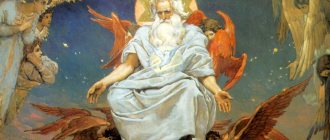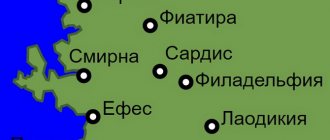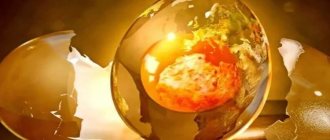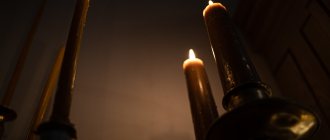There are exactly seven seals, because this is an important number for the Biblical tradition
Needless to say, the 7 seals of the apocalypse are not a random number. In the Jewish tradition, we met it regularly: 7 days of creation, 7 years of Jacob’s labor for Rachel, fasting for 7 days, and so on.
But the seven itself is much older than the Bible. It appears in many of the most important elements of culture and the world around us:
- 7 days of the week;
- 7 notes;
- 7 colors of the rainbow.
7
a number that occurs frequently in our world and has permeated many cultures
Eastern traditions will tell you about the seven chakras, etc., etc. What is important is not this, but the fact that people from ancient times decided that 7 was a special number in our world, and therefore treated it with respect.
The Book of Revelation of John the Theologian is built from chains of sevens:
- Seven Seals;
- Seven angels who sound trumpets;
- Seven bowls.
We are successively described to what each element of these sevens corresponds to. In other words, let's say the angel poured out the cup - something happened.
After every sixth element there is a small compositional digression, and every seventh element launches the next seven. This is how the book of Revelation is interestingly structured.
Literal translation of the word Apocalypse
Icon of the Revelation of John the Theologian
Translated from Greek, this word means “revelation.” In a narrower sense, as the Books of the Holy Scriptures, they are a special revelation of God given to the Apostle and Evangelist John the Theologian. Therefore, in the Russian translation, this Holy Book is called: “The Revelation of St. John the Theologian.” It is this Holy Book that will be discussed in this publication.
But in the preface it should also be noted that the name apocalypse in the world is applied to various natural disasters, especially those of a monstrous nature. In addition, this name often also means the end of the world. What stimulates the imagination of today's science fiction writers, especially from the field of cinematography.
Hence one of Hollywood's favorite plots - films about the post-apocalypse world, i.e. about what supposedly will happen after the end of the world. Caused either by some natural phenomena, or, as often happens in movies, by the third world war with the use of nuclear weapons.
As a rule, this post-apocalyptic world looks very unpresentable. Some wild, bad guys, survivors of a global catastrophe, in the same ridiculous cars or motorcycles, are chasing the unfortunate, also survivors, but good guys and girls with the aim of robbing, enslaving or killing them; and sometimes for the purposes of cannibalism. But, of course, more often than not the good ones win in Hollywood...
True, skeptics, realistically assessing this fantasy, quite reasonably point out at least the fact that in the event of such a worldwide catastrophe, the oil refining industry, due to its extreme vulnerability, will be the first to be destroyed. And since gasoline can be stored for no more than five months, after which it turns into some kind of jelly, completely unsuitable for motor transport, cannibal savages will have nothing to drive in the event of a real disaster; well, maybe except for the hot (or combustible?) imagination of Hollywood scriptwriters and directors.
Another noteworthy thing is this. Although these figures call their scripts and films of this kind post-apocalyptic, meaning the end of the world, in fact they do not at all correspond to the real Apocalypse of St. John the Theologian. By the way, other apocalyptic predictions and forecasts of more serious figures than Hollywood ones do not correspond to this: politicians; sociologists; futurists and similar personalities.
For all of them, humanity may die from some kind of global catastrophe, for example, environmental, global warming or the fall of a giant meteorite, epidemic, etc. But most often, as already mentioned, the third world war with the massive use of nuclear weapons is presented as such the end of the world.
The real Apocalypse actually speaks of terrible disasters and wars. However, it is not they that will become the cause of the demise of the world, but the general and deepest moral decline of humanity, which led to its submission to the Antichrist and, as a result, to the most significant damage to human nature. However, this will be discussed in more detail below.
In Revelation, Jesus Christ, in the form of a lamb, opens these seals from the book
The author of the revelation describes a certain lamb, that is, a lamb. This is not a random and very ancient symbol. The fact is that our ancestors treated large herbivores with special respect. Somewhere it was a cave bear, but it was exterminated. Large horned animals were predominantly venerated, as evidenced by rock paintings and other signs such as primitive altars.
At some point, the idea arose that revered animals should be killed and sacrificed. The ancestors left no clues about why this was done. But their descendants interpreted the custom in their own way - and the ritual of sacrificing such animals spread throughout the world.
The Lamb represents Christ, for animals have been associated with God since ancient times.
Lambs and kids are among the most common sacrificial animals. They were often killed as a substitute sacrifice - that is, instead of themselves, as the closest to God, a sacred animal. And, for example, in ancient Canaan the idea that an animal is close to God was not recognized. There they sacrificed their firstborn in their place.
One way or another, the parallel between God and a horned animal has survived to this day. In Christianity we can find it, say, in the image of a cross between horns. Jesus in the guise of a lamb is an echo of ancient symbolism. On the one hand, this emphasizes the divine nature of the Messiah, and on the other hand, it illustrates His sacrificial position as the One who suffered for the sins of others.
The book from which the seals are broken is a scroll
We are used to presenting books as we see them. But it is worth remembering that bound books and codices appeared later than the Revelation of John the Theologian was recorded. The author, having seen the bound book, would hardly have called it a book at all. Obviously, he meant the scroll on which the seals are located.
Well, a seal is, of course, not an ink mark that is placed to confirm the authenticity of documents. Seals are usually wax locks that prevent the scroll from being opened without leaving a mark. That is, it is implied that only one worthy person can open that very Book of Revelation - Jesus Christ.
Now that we have covered all these points, there will be no difficulty in understanding what the author is writing about:
“And I cried a lot because no one was found worthy to open and read this book, and even to look into it. And one of the elders said to me: do not cry; Behold, the Lion of the tribe of Judah, the Root of David, has overcome, [and can] open this book and open its seven seals. And I looked, and behold, in the midst of the throne and the four living creatures, and in the midst of the elders, stood a Lamb as it had been slain, having seven horns and seven eyes, which are the seven spirits of God sent out into all the earth.”
(Rev. 5:4–6)
Similar scrolls were used in the ancient world; it is on such a book that the seals in the Revelation of John the Theologian are found. Photo: stmegi.com
Harbingers of the end of the world
In the Book of Revelation, which stands out strongly from other texts of Holy Scripture, the following sequence of events is observed:
- Jesus Christ appears with a message to the seven Churches.
- John ascends to the holy throne and meets with the holy elders.
- The seals are removed from the holy book.
- Seven angels appear, bringing catastrophic events to Earth.
- There is a meeting with the characters of Revelations.
- God sends bowls of wrath to Earth.
- The unclean one comes and is cast into the lake of fire.
- The Judgment of God will take place.
- New heaven and earth are being created.
Revelation does not say when exactly the end of the world will happen. However, there is mention of a millennial kingdom. In this regard, the events of the apocalypse are usually associated with the transition of millennia.
We decorate ordinary fabric organizers. It turns out stylish and unusual
Yorkshire Terrier and Labrador at risk: which dogs are susceptible to obesity
Adding wood ash to the soil: how to prepare a greenhouse for the summer season
The book contains a huge number of symbols, the meaning of which people have been trying to unravel for centuries. Here are the interpretations of some of them.
The first seal - the appearance of the first horseman of the apocalypse
Each seal not only brings the narrator closer to the opening of the mysterious scroll, but also reveals to him the terrifying events of the Book of Revelation. Removing the first seal results in the appearance of a mysterious character:
“And I saw the Lamb open the first of the seven seals, and I heard one of the four living creatures saying as with a voice of thunder, “Come and see.” I looked, and behold, a white horse, and a rider on it had a bow, and a crown was given to him; and he went out [as] victorious, and to conquer.”
(Rev. 6:1–2)
White color is associated with something divine. And the character himself is described quite attractively. Many interpreters support each other that this is Jesus Christ. But at the same time, how can it be Him if at the same time the Messiah in heaven is busy opening the seal?
Philip Jacob Lutherburg Jr., "The Opening of the Second Seal." The painting depicts the first horseman of the apocalypse, and behind him appears the second - he is usually identified with war. Photo: fermer.ru
If you think about it, yes. After all, Christianity most often represents Christ as God or the Son of God, but not as a man. Can the laws of time and space limit Him? And in general, the Revelation of John the Theologian is a symbolic book; is it correct to evaluate its facts rationally?
But since the four horsemen of the apocalypse are mentioned together, isn’t it logical that they are all of the same nature? The next three are clearly dangerous phenomena for humans. Why would a rider on a white horse be considered something good? His godlike appearance may be a deception, and therefore many interpreters consider this horseman to be the Antichrist.
Signs of the apocalypse and its 4 horsemen
Ten visions and their interpretation
Seven golden lamps
The first vision of the Apostle John the Theologian is of seven golden lamps, symbolizing the seven Churches “located in Asia: in Ephesus, and in Smyrna, and in Pergamum, and in Thyatira, and in Sardis, and in Philadelphia, and in Laodicea” (cf. Rev. .1: 11). Among these lamps he sees the Son of Man, the Lord Jesus Christ, who reveals to him the secret of these seven Churches, praising those who are faithful in them and convicting those who are erring.
On the one hand, all these Churches actually existed at that time, and therefore this revelation deals with real events of that time. So, for example, the Lord glorifies the bishop of the Church of Pergamon, Hieromartyr Antipas (Rev. 2: 12-13). Who really suffered for Christ at that time, during the persecution of Nero, around the year 68 he died as a martyr.
But on the other hand, some interpreters of Holy Scripture see in these seven Churches the symbolic history of the Christian Church, which is divided into seven periods. Moreover, the last period (the Church of Laodicea) is characterized by a complete impoverishment of Christian piety. And the Lord only denounces the Angel of this Church, without finding a single word of praise for at least some of its members.
Which very much corresponds to the present time of general apostasy, i.e. apostasy from God. An interesting detail: the Lord denounces this angel like this:
“I know your deeds; you are neither cold nor hot; Oh, that you were cold or hot! But because you are lukewarm, and neither hot nor cold, I will spew you out of my mouth” (Rev. 3: 15-16).
St. John Cassian the Roman explains this passage in the sense that in the nature of fallen man there is a struggle between the flesh and the spirit. This is allowed by God so that we can overcome the flesh in spirit, which is what Christians are basically called to do. But when they strive to maintain, so to speak, a balance between spirit and flesh, pleasing both, then they become “neither hot nor cold”! Which is very displeasing to God and, let us note, very much corresponds to the appearance of Christianity of our time.
Throne of God, elders, animals and crystal sea
The second vision of the Apostle John the Theologian is the throne of God and Him who sits on it, as well as around twenty-four thrones, on which twenty-four elders sit, and four winged animals, which constantly give glory to God. In front of the throne is a crystalline sea of glass (Rev. 4: 1-11).
According to the interpretation of the holy fathers, this sea, clear as crystal, is the font of Christian baptism, for a person can only come to the throne of God through it. So these chosen elders came to him, apparently both Old Testament and New Testament. After all, the Lord said to the apostles:
“Truly I say to you, that you who have followed Me, in the end of life, when the Son of Man sits on the throne of His glory, you also will sit on twelve thrones, judging the twelve tribes of Israel” (Matthew 19:28).
And the four animals are a clear symbol of the four Gospels, through which the whole world was brought to the foot of the throne of God.
Book sealed with seven seals
The third vision of the Apostle John is a book “in the right hand of him who sits on the throne, sealed with seven seals,” which no one living could open. It is given only to the Lamb of God, as if slain, to open it - the Lord Jesus Christ (Rev. 5: 1-14).
One can express the opinion that this speaks in more detail about the Eternal Council of the Most Holy Trinity (Gen. 1: 26) before the creation of man. Advice is always some hesitation before taking one action or another. In God, of course, there is no such hesitation, but humanly, for our understanding, this Eternal Council testifies that God is not the creator of evil. Therefore, foreseeing the Fall together with the progenitors Adam and Eve of all mankind, the Lord seemed to be indecisive before his creation.
But the Sacrifice of the Lamb of God on the Cross (slain from the foundation of the world, for the decision about this Sacrifice was made at this Eternal Council), which redeemed humanity, brought about not only our salvation, but also the possibility of the creation of humanity for the sake of this future redemption and salvation.
Hence the meaning of the seven seals of this book, which only the Lamb could open, is clear. They mean the damage of the earthly world by evil, which is directly stated regarding the third seal - “do not damage” (Rev. 6: 6). Why, in fact, these seals of the book of the existence of the human race could not have been opened by anyone other than Christ.
Opening of Seals and Horsemen of the Apocalypse
The fourth vision of the apostle is the gradual opening of these seals. Some highlight here the four horsemen of the apocalypse, but I think that this is only a fragment of this process of opening the seals. Yes, the horsemen, of course, are very symbolic and ominous, but, I repeat, this is only a fragment, albeit a very important one.
In this regard, it seems that the first, white horseman is not the Second Adam Christ, as some believe, but only the first Adam, “who came out victorious to overcome” (Rev. 6:2). But out of pride, he wanted to become “like the gods” (Genesis 3:5), and because of this he committed the Fall, into which he led the entire human race.
The second seal and the second rider on the red horse, because of this fall, who took peace from the earth (Rev. 6: 3-4) not only in the sense of endless wars, but also put the above-mentioned struggle between spirit and flesh in human nature itself. These are also all other types of wars: pagans or atheists against Christians; family wars between, for example, mother-in-law and daughter-in-law, etc.
The third seal and the third rider on a black horse are also a consequence of the fall of our ancestors, consisting in the introduction of commodity-money relations. While the first parents lived in paradise, they had everything in abundance, and without working, they did not need anything. After the expulsion from paradise, when abundance ended and in order to live, one had to work (Gen. 3: 17-19), then the measure of a particular product became the labor put into it. This is where commodity-money relations arise and this difference in the price of wheat and barley (Rev. 6: 5-6).
Wine and oil here are a symbol of alms, because they were poured on the wounds of the victim by the merciful Samaritan (Luke 10:34). But in general, this (Rev. 6: 6) means that alms stands above commodity-money relations and is not damaged by them.
Finally, the fall of our first parents introduced death into the world:
“Therefore, just as through one man (Adam) sin entered into the world, and death through sin, so death spread to all men, because all sinned in him” (Rom. 5:12).
What is evidenced by the opening of the fourth seal and the rider on the pale horse - death (Rev. 6: 7-8).
These are the main troubles of fallen humanity, affecting every person without exception. Therefore, apparently, they are presented precisely in the form of these terrible apocalyptic horsemen.
As for the fifth seal, the damage of the evil of this world does not apply to all people, but only to the saints (Rev. 9: 9-11). Therefore, its removal is done without the sinister horseman, and means what the Lord said to his apostles and all true Christians:
“In the world you will have tribulation” (John 16:33).
And what the Apostle Paul said in more detail about the saints is this: they “experienced insults and beatings, as well as chains and prison, were stoned, sawn apart, tortured, died by the sword, wandered in mantles and goatskins, suffering disadvantages, sorrows, and bitterness.” ; those of whom the whole world was not worthy wandered in the deserts and mountains, in the caves and caves of the earth” (Heb. 11: 36-38).
As we see, this is another consequence of the damage to the world by the Fall. Those whom the whole world was not worthy of, due to the malice of this world, experienced the greatest sorrows and troubles. It is enough to remember at least the martyrs of Christ!
Finally, the opening of the sixth seal by all indications means the end of the world or the end of this sinful world ((Rev. 6: 12-17). However, there is something good in it, namely holy people, whom the Angel seals with the “seal of the living God” (Rev. 7: 2). And although this chapter talks about the sealing of people from all the tribes of Israel (Rev. 7: 4), but in fact this is the seal of the gift of the Holy Spirit, given to the faithful in the Sacraments of Baptism and Confirmation. And those mentioned here one hundred and forty-four thousand are the greatest saints, whose names and lives we know only in part, and only God knows all their names and lives (Rev. 7: 1-17)!
From this it is clear why after the opening of the seventh seal “there was silence in heaven for as much as half an hour” (Rev. 8: 1). The prayers of the saints calm the wrath of God (Rev. 8: 3-4), but because of our sins - not for long, “as if for half an hour.” And again the wrath of God falls upon fallen, sinful humanity in the form of seven Angels who had seven trumpets. After the cry of each of them, certain natural disasters and wars fall on people (Rev. Chapters 8 and 9), ending with the end of the world and the Last Judgment of God (Rev. 11:15-19).
Two Witnesses of God: Enoch and Elijah
The fifth vision of the apostle is of two witnesses of God who will preach for 1260 days (Rev. 11: 3), i.e. approximately the time of the reign of the Antichrist. According to patristic tradition, these saints are Enoch and Elijah (some believe that St. John the Theologian himself will preach with them), who were taken alive to heaven. But when the Antichrist comes, they will come down from heaven and denounce him, in particular, warning people against accepting his seal.
Finally, the Antichrist will defeat and kill them, but after three and a half days they will be resurrected and ascend to heaven; Moreover, this will be accompanied by a terrible earthquake; seeing these miracles, many people will repent (Rev. 11: 7-13). The secret of this victory of the Antichrist, perhaps, is that Enoch, Elijah and, perhaps, the Apostle John the Theologian, after death, like Christ, descended into hell, and there they will preach, already before the end of the world, tormenting the souls of sinners who believed them preaching to people from hell. However, this is only a personal opinion, which may be incorrect.
Woman Clothed with the Sun
The sixth vision of the apostle is “a woman clothed with the sun; under her feet is the moon, and on her head is a crown of twelve stars. She was with child, and cried out in pain and pangs of birth” (Rev. 12: 1-2). According to the interpretation of the holy fathers, this wife is the militant Church, and she gives birth to a new man. What the Lord said:
“When a woman gives birth, she suffers sorrow, because her hour has come; but when she gives birth to a child, she no longer remembers the sorrow for joy, because a man was born into the world” (John 16:21). She gives birth to him in sorrows, for according to the words of the Apostle Paul, “through many tribulations we must enter the kingdom of God” (Acts 14:22).
She gives birth to the children of God, those “who were born neither of blood, nor of the will of the flesh, nor of the will of man, but of God” (John 1:13).
War of the Church with the ancient serpent
And the Church is at war with the dragon, “the ancient serpent, called the devil and Satan” (cf. Rev. 12: 3-6; 9; 13-17) - and this is already the seventh vision of the apostle. Which depicts the ancient story of how the first of the angels, Dennitsa, became proud, fell away from God, declaring himself a god, and carried away a third of all the angels with him (Rev. 12: 4), thereby disrupting the harmony of the angelic ranks.
The archangel Michael stood against him, whose name is translated “who is like God” - with these words, the archangel Michael and other angels faithful to God fought against Satan and his angels, defeating them and casting them to earth (Rev. 12: 7-12).
Devil and Antichrist
In rage, the devil, having fallen to earth, gives birth to his likeness - the Antichrist (Rev. 13: 1-10) and his false prophet (Rev. 13: 11-18). And this is already the eighth vision of the apostle. Note that seven diadems on the heads of the devil and ten on the heads of the Antichrist are the crowns with which the saints who defeated them are crowned. As we see, more crowns are given for victory over the Antichrist.
However, the main thing that worries believers of all times, especially ours, is the following action of the false prophet:
“He will cause everyone, small and great, rich and poor, free and slave, to receive a mark on their right hand or on their foreheads, and that no one will be able to buy or sell except the one who has this mark. , or the name of the beast, or the number of his name. Here is wisdom. He who has intelligence, count the number of the beast, for it is a human number; his number is six hundred and sixty-six” (Rev. 13: 16-18).
There are a lot of speculations about this mark, which is also called the seal of the Antichrist. In particular, there were debates about this during the introduction of identification codes. Some thought that these codes were this very seal.
But according to the teaching of the Holy Fathers, rather this passage of Holy Scripture (Rev. 13: 16-18) should be understood in the context of the previous 14-15 verses of this chapter of the Apocalypse:
“And with the miracles that it was given to him to do before the beast, he deceives those who dwell on the earth, telling those who dwell on the earth to make an image of the beast, which has the wound of the sword and lives. And it was given to him to put spirit into the image of the beast, so that the image of the beast would both speak and act, so that everyone who would not worship the image of the beast would be killed” (Rev. 13: 14-15).
By nature, man is the image and likeness of God (cf. Gen: 1:26). The main action of the false prophet is to replace the image of God in man with the image of the Antichrist, for which this seal of his serves. Apparently, it is a future bioelectronic device, relatively speaking, implemented on the forehead (i.e., controlling a person’s mental power) and on the hand (controlling his active power).
This device will be capable, on the one hand, of suppressing natural human actions, especially those relating to even the simplest manifestations of Christian piety. For example, if someone wants to cross himself, even instinctively, his hand will be blocked by this seal, and he will not be able to do it. In the same way, his mental power will be blocked when, for example, he tries to say in his mind at least “Lord have mercy.” It is possible that such instinctively ephemeral attempts at natural piety will be accompanied as punishment by a painful shock, also received from this vile seal.
On the other hand, it will transmit into the person who voluntarily, or rather, willfully accepted it, the image of the Antichrist, who himself is the image of his father - the devil. And such a person will begin to think, act, and feel not independently, like a person, but like the Antichrist. In other words, it is no longer he who begins to live, but the Antichrist begins to live in him, and through him the devil.
Actually, this is how the retinue fathers explain the effect of this accursed seal, under the influence of which those who accepted it become demon-like, turning into a kind of demons in the flesh. This is how, for example, the Venerable Nile the Myrrh-Streaming describes this dark future of humanity in his posthumous prophecies.
Or, for example, another place from these prophecies. When Enoch and Elijah warn people against accepting the seal of the Antichrist, says St. Neil, some will object to them, saying that those who accepted this seal praise it very much. To which these saints will say: “It is not they (these people) who speak, but the Antichrist speaks in them.”
What we see as another borrowing of Satan from Christianity. He, not possessing creative potential, cannot create anything himself, but, like a thief, he steals something from God. In this case, theft is obvious, because Christians strive for Christ to begin to live in them. What do the most perfect of us achieve, like, for example, the Apostle Paul, who said about himself: “It is no longer I who live, but Christ who lives in me” (Gal. 2:20). And Satan, by analogy, with the help of that seal, will try to ensure that the Antichrist lives in those who accept it, and through him the devil himself!
Moreover, the difference between those in whom Christ lives and those in whom the Antichrist will live is also obvious. The first occurs in a spiritual way and without violating human freedom, the second - in an electronic-mechanical way, not just grossly violating human freedom, but completely abolishing it. He who accepts the seal of the Antichrist becomes his electronic slave, and, moreover, an absolute slave. Therefore, what is most depressing is that repentance is no longer possible for him. But the most important thing is man: compare the good Christ God and the vile evil son of Satan the Antichrist, and it will become clear who to choose to live in your soul!
A few words about the already mentioned identification codes. From all of the above, it is obvious that they are not the seal of the Antichrist. Because they are not yet capable of introducing anything into a person. A similar device, this very seal, has not yet been created. But there is no doubt that many scientists around the world are indirectly or even directly working on its creation. After all, completely controlling a person is the dream of all tyrants and totalitarian regimes, and the press can do this, which the Antichrist will take advantage of in his time. Well, his false prophet, obviously, will, among other things, also be a great scientist.
So what about the codes? The Russian Orthodox Church conciliarly and absolutely correctly decided that accepting them is not a sin. But, taking into account the very, very dubious component of these codes (for example, the number 666 they contain), we can say that their acceptance, which is not a sin, is also not a virtue. But their rejection by Orthodox Christians for this reason of their doubtfulness is already a virtue. But only if such a Christian, submitting to the Church, does not consider their acceptance to be a sin and therefore does not condemn those who accepted them.
The Great Harlot
The ninth vision of the apostle is of the great harlot (Rev. 17: 1):
“And I saw a woman sitting on a scarlet beast, full of blasphemous names, having seven heads and ten horns. And the woman was arrayed in purple and scarlet, adorned with gold, precious stones and pearls, and had a golden cup in her hand, filled with abominations and the uncleanness of her fornication; and on her forehead was written a name: mystery, Babylon the great, the mother of harlots and abominations of the earth” (Rev. 17:5).
We are talking about the Whore of Babylon, who I think personifies carnal humanity. Which, although it serves God, is hypocritical, caring more about its flesh than about Him. And this very thing, supposedly their “service” to God, they carry out in a carnal way. And this in itself is both disgusting and godless!
So already both main events that gave the name to the Whore of Babylon testify to this. In its most literal sense, the name means temple prostitution, practiced in the Babylonian temples of depravity. According to the religious concepts of these Babylonian pagans, every girl or woman, from the royal family to the very last commoners, had to visit such a temple at least once as a harlot, “worshipping their prodigal deity in such a disgusting way.” What could be more disgusting than such “serving God” in such a vile, carnal way?!
And the second event of the same kind is the construction of the notorious Tower of Babel (Gen. 11: 1-9). When people, using the latter as a brick staircase, wanted to ascend to heaven in the simplest, in their opinion, way, in dirty boots and with dirty souls. As we see, the same religious attempt to ascend to heaven in a carnal way.
Yet particular manifestations of the Whore of Babylon, for example, the Jewish people, are often called harlots in the Bible; Roman Catholic or some other secularized church; the current West, especially America and others, are only partial manifestations of this great harlot in the history of mankind.
The conflict between this harlot and the beast-Antichrist, on which she originally sat, is also interesting: “And the ten horns that you saw on the beast, these will hate the harlot, and destroy her, and strip her naked, and eat her flesh, and burn her with fire; because God has put it in their hearts to do His will, to do one will, and to give their kingdom to the beast, until the words of God are fulfilled” (Rev. 17: 16-17). Indeed, here the Antichrist, who from beginning to end is the enemy of God, is right in relation to the harlot, therefore he defeats and eradicates her. For one cannot serve God hypocritically, according to the flesh; one must either love Him or hate Him (cf. Matt. 6:24)—the latter is what the beast does without any hypocrisy, unlike the hypocritical harlot.
Victory of Christ
And finally, after the victory of Christ over the Antichrist and the devil (Rev. 19: 11-21; 20: 7-10), after the end of the world and the Last Judgment of God (Rev. 20: 11-15), the tenth vision of St. John follows Theologian - the marriage of the Lamb of Christ with His bride, who is the triumphant Church (Rev. 21: 1-27). This also means the greatest blessedness of the faithful with Christ in the Kingdom of Heaven, to which every Christian is called (Rev. 22: 1-21).
The Second Seal - the arrival of the second horseman of the apocalypse
If there are questions with the first rider, there are usually no doubts about the second. It is identified with war:
“And when he opened the second seal, I heard the second living creature saying, Come and see. And another horse came out, a red one; and to him that sat on it was given power to take peace from the earth, and that they should kill one another; and a great sword was given to him"
(Rev. 6:3–4)
These are the horrors of the last times that the Word of God promises - but this is just the beginning!
The third seal - the appearance of the third horseman of the apocalypse
The opening of the third seal predictably ends with the arrival of the third horseman:
“And when He opened the third seal, I heard the third living creature saying, Come and see. I looked, and behold, a black horse, and its rider had a measure in his hand. And I heard a voice among the four living creatures, saying: A quinix of wheat for a denarius, and three quinixes of barley for a denarius; But thou shalt not spoil the oil and wine.”
(Rev: 6:5–6)
This character is identified with hunger.
The third horseman. He appeared after the third seal was opened. 13th century illustration from Apocalypse de Douce. Photo: fermer.ru
Message to the Seven Churches
The prologue of the Apocalypse describes the appearance of the Son of God. He is clothed in a podir - an ancient Jewish outer long garment worn by kings and Old Testament priests. He is among the seven lamps and holds seven stars in his hand. And there is also a message to the seven Churches:
Write to the angel of the church of Ephesus: Thus says He who holds the seven stars in His right hand, He who walks in the midst of the seven golden lampstands.
The seven lamps symbolize the seven Churches, that is, the seven Christian communities that existed in Asia Minor. The founder of the Ephesian community was the Apostle Paul. According to another interpretation, the seven Churches mentioned by John are seven stages that characterize the life of the Church. The seven stars are the angels through whom Christ rules the Church.
The fourth seal - the coming of the fourth horseman of the apocalypse
The fourth seal opens the way for the last of the horsemen of the apocalypse:
“And when He opened the fourth seal, I heard the voice of the fourth living creature, saying, Come and see. And I looked, and behold, a pale horse, and its rider, whose name was “death”; and hell followed him; and power was given to him over the fourth part of the earth, to kill with the sword, and with famine, and with pestilence, and with the wild beasts of the earth.”
(Rev: 6:7–8)
In the original, the color of his horse is pale green, but the translators felt that for the Russian reader, pale would be more associated with death, since this color corresponds to the impression that a pale green horse made on ancient readers.
Hell is a mistranslation. In the original - hades, that is, the kingdom of the dead in principle, and not a place where sinners languish.
By the way, this is the only rider whose name (meaning) is given.
On the Polyptych of St. John (1470s) Hans Memling depicted, instead of hell, which follows the 4th horseman of the apocalypse, a certain demon - the personification of hell. This is an illustration of the breaking of the fourth seal. Photo: fermer.ru
The fifth seal is the observation of those killed for the word of God
The pattern stops working for those who expected to see the next horseman behind the fifth seal. The author depicts those killed for the word of God. From the context, it appears that these are people who have yet to be killed at the time of writing, although this is not explicitly stated. It is possible that this means all those who suffered for their faith.
“And when He opened the fifth seal, I saw under the altar the souls of those who had been slain for the word of God and for the testimony which they had. And they cried out with a loud voice, saying: How long, O Lord, Holy and True, do you not judge and avenge our blood on those who dwell on the earth? And white robes were given to each of them, and they were told to rest for a little while longer, until their fellow servants and their brothers, who would be killed like them, would complete the number.”
(Rev: 6:9–11)
The Austrian artist Karl Rossing depicted the horrors of revelation in contemporary Vienna in the 40s. Photo: fermer.ru
Author, place and time of writing of the Apocalypse
John the Theologian in silence School or art. center: Russian North Second half of the 16th century. Wood, tempera. 102 × 85 cm State Tretyakov Gallery, Moscow, Russia Inv. 12055 See in the "Gallery":
The Apostle John the theologian himself speaks about this:
“I, John, your brother and companion in the tribulation and in the kingdom and in the patience of Jesus Christ, was on the island called Patmos for the word of God and for the testimony of Jesus Christ” (Rev. 1:9).
Thus, the place where the Apocalypse was written was the island of Patmos, where the apostle was exiled during the persecution of Christians.
This is interesting: The Holy Apostle John the Theologian revealed all the secrets through the word
The question of what kind of persecution it was still causes controversy among church historians. So in the lives of St. Demetrius of Rostov says that this was under the Emperor Domitian (reigned from 81 to 96). But, most likely, this was during the time of Nero (54-68), who organized an unusually fierce, brutal, one might even say, bestial persecution of Christians! Therefore, many at that time considered him an apocalyptic beast-antichrist.
Based on this, we can assume that the time of writing the Apocalypse is the end of the reign of Nero, i.e. 68 or 69 A.D. According to the life, St. St. John was captured by the ruler of Asia and sent to Rome, where Caesar himself subjected him to torture. However, when the apostle drank a cup of deadly poison and then, being thrown into a cauldron of boiling oil, but preserved by the Lord, remained alive, the superstitious pagans decided that he was immortal. Therefore, as a preventive measure, he was sent into exile on the mentioned island. However, the Lord predicted all this in advance to his beloved disciple. Appearing to him in a dream, He said: “It is fitting for you to suffer much, and you will be banished to some island that is in great need of you.”
So, from here we can judge the, so to speak, quality of the time when the Apocalypse was written. As has already been said, this is the time of Nero’s fierce persecution of Christians. To characterize the latter, it should be noted that this emperor was distinguished not only by the extreme depravity of his character, but also by incredible extravagance and tyranny.
So, for example, he considered himself “the greatest poet of all times,” equal to or even superior to Homer. But as a “bad dancer,” something always prevented him from writing a poem equal to the Iliad. Finally, this emperor-poet decided that the whole problem was that Homer saw the destruction of Troy with his own eyes, but he, Nero, did not.
Therefore, as fairly reliable historical sources report, he decided to personally organize something like the death of the great city of Rome, ordering it to be set on fire. And at the same time he watched the fire, sitting on one of the nearby hills, and there, on occasion, he wrote his absurd verses, trying to compare with Homer. When he himself was suspected of setting fire to Rome, he shifted the blame for this onto Christians, accusing them of this crime.
This false accusation served as the formal reason for Nero’s unusually fierce persecution. When Christians were subjected to the most sophisticated tortures that brutal pagans could invent.
This struggle between Christianity and paganism, light and darkness, good and evil, where, despite the seeming temporary triumph of evil, the power of God defeats good, was reflected in the Apocalypse.
But besides the direct, so to speak, physical persecution of Christianity, paganism also revealed another, much greater danger for the Church of Christ. We are talking about Gnostic sects or the Gnostic heresy. They arose long (six centuries) before the advent of Christianity. And they were a mixture of paganism and Judaism, professed by a number of sects, with very diverse creeds, morals and rituals. They were united only by some common features.
One can make a more or less reliable assumption that Gnosticism was conceived by Satan as the future main enemy of Christianity, the future appearance of which this enemy of the human race knew from Old Testament prophecies. Therefore, this satanic false teaching was supposed to be a kind of “homing torpedo” that itself was supposed to hit the church ship as soon as it appeared on the horizon of history.
This, in essence, is what happened, but by no means without a fatal outcome for Christianity. And his first encounter with Gnosticism was associated with the name of Simon the Magus, who was originally one of the rather significant Gnostic false teachers (cf. Acts 8: 9-12). However, having seen the miracles that the apostles performed, Simon himself was baptized (Acts 8: 13), but did not preserve the purity of faith, creating his own new false teaching, in which he tried to connect Christianity with Gnosticism, becoming the founder of the heresy, so to speak, “Christian” Gnosticism. For which he was condemned as the first Christian heresiarch (cf. Acts 8: 23).
Subsequently, the Christian-Gnostic sects, like rotten things after rain, multiplied. And Gnosticism for a long time (until the middle of the second century) became the main rival of Christianity. This struggle is also reflected in the Apocalypse.
So, for example, when it talks about the dragon who was going to devour the child born of “the woman clothed with the sun” (Rev. 12: 1-6), and then it says: “And the great dragon was cast out, the old serpent, called the devil and by Satan, who deceives the whole world, he was cast out to the earth, and his angels were cast out with him” (Rev. 12:9) - here we are talking not only about the eternal struggle of Satan with the Church of Christ, but also about very specific events.
The fact is that Gnosticism itself arose as a satanic sect of snake worshipers. Moreover, they worshiped precisely that “ancient serpent” who seduced Adam and Eve in paradise (Gen. 3: 1-7), considering him a completely decent creature. Therefore, the first Gnostic sects were called Ophites or Naasenes, which, in fact, means the same thing - snake worshipers, only the first is in Greek, and the second in Hebrew.
Moreover, the main method of drawing Christians into their sects among the Gnostics was precisely the seduction of converts and still inexperienced neophytes, i.e. these same babies born by the Church. Which is reflected in this place of the Apocalypse.
Or, for example, another place:
“But to you and to the others who are in Thyatira, who do not hold this teaching and who do not know the so-called depths of Satan, I say that I will not place another burden on you; Only hold on to what you have until I come” (Rev. 2: 24-25).
Here, as well as in the context of this passage of Holy Scripture (Rev. 2: 18-27), we are clearly talking about some kind of Gnostic sect among the Christians of the Thyatira Church.
Because “depth” or in Greek “pathos” is one of the main aeons (outflows from the Gnostic “deity”) in the false teachings of the Gnostics. Probably, the sectarians during their “zeal” fell into some kind of delightful states, experiencing fornication excitement. But, however, those who believe that in this way they are united with this eon-depth, i.e. his "deity". In contrast to this misconception, St. John the Theologian calls this “eon” not divine, but satanic - “the depths of Satan.”
When did the book of Revelation enter the New Testament canon?
Although references and quotes from the Revelation of St. John the Theologian are found in church writers as early as the second century (Tertullian and St. Irenaeus of Lyons), this Book was included in the canon of the New Testament much later. Even in the 60th rule of the Laodicean Local Council (364), which lists the canonical New Testament Books, it is not there. And only at the Council of Hippo (383) and, most importantly, the Council of Carthage (419) - rule 33, it was finally included in the New Testament canon.
Such a slowdown in recognizing the canonicity of the Apocalypse was associated precisely with the destructive activities of the Gnostics. Who, imaginary considering themselves “apostles,” compiled many forged works, which they presented as real “New Testament books.” Thus, in particular, for example, the “Gospel of Thomas” is known.
By the way, I had the opportunity to read it at the dawn of my Christian youth. And although I was still a completely inexperienced Christian at that time, I immediately felt a significant difference. For when I read the true, canonical Gospels, I felt the light of Christ enlightening my soul. When I read this work, supposedly “Thomas”, then (despite the fact that it was full of quotations from the canonical Gospels) I felt darkness envelop my soul
What interpretations and guides to the study of the Apocalypse can be recommended to the modern reader?
Of course, an enduring example of this is the “Interpretation of the Apocalypse of St. John the Theologian,” given by St. Andrew of Caesarea. Although it was written almost one and a half thousand years ago (between 563 and 614), it represents the only example of a complete patristic interpretation of the Apocalypse. Served as the basis for other interpretations.
Of the more modern works of this kind, one should refer to the Explanatory Bible by A.P. Lopukhin (published in the late nineteenth and early twentieth centuries), which also gives a general interpretation of the Revelation of St. John the Theologian.
Of the more modern Orthodox works of this kind, one can point to the “Interpretation of the Apocalypse” by Archpriest John Pavlovtsev, published in 2022.
Now is the time to directly turn to the interpretations of this most mysterious New Testament Holy Book.
Sixth Seal - Cataclysms
The opening of the sixth seal triggers terrible cataclysms:
“And when He opened the sixth seal, I looked, and behold, there was a great earthquake, and the sun became dark as sackcloth, and the moon became like blood. And the stars of heaven fell to the earth, as a fig tree, shaken by a strong wind, drops its unripe figs. And the sky disappeared, curled up like a scroll; and every mountain and island moved from their places. And the kings of the earth, and the nobles, and the rich, and the captains of thousands, and the mighty, and every slave and every free man, hid themselves in caves and in the ravines of the mountains, and said to the mountains and stones: Fall on us and hide us from the face of Him who sits on the throne and from the wrath of the Lamb; For the great day of His wrath has come, and who can stand?”
(Rev: 6:12–17)
Although the reader may expect that now there will be another description and the seven seals will end, the author follows a strict composition, where after every sixth element there is a digression. The entire seventh chapter is devoted to a description of events at the throne of God, as well as angels at the four ends of the earth.
Four animals
The number “four” in this case symbolizes the four cardinal directions and four different living beings, which together speaks of the completeness of the created world, which is united in worship of the Creator:
Experts say the world will switch to cultured meat in a few years
“My favorite daughter gets bonuses”: an Australian shared his education system
Real damage from unrealistic dolls: why Barbies can be dangerous for children
And in the midst of the throne and around the throne were four living creatures, full of eyes in front and behind. And the first living creature was like a lion, and the second living creature was like a calf, and the third living creature had a face like a man, and the fourth living creature was like a flying eagle. And each of the four animals had six wings around, and inside they were full of eyes; and they have no rest day or night, crying out: Holy, holy, holy is the Lord God Almighty, who was, is and is to come.
We are talking about four animals, which are understood as the highest ranks of angels. Their description contains features of cherubim and seraphim. The first are marked by the prophet Ezekiel, and the second by the prophet Isaiah. The presence of many eyes and four faces is characteristic of the cherubim, while six wings and the cry “holy, holy, holy” are from the seraphim.
The seventh seal - the transition to the seven bowls
Every seventh element of the list is a transition to the next list of seven elements. Therefore, the seventh seal has not only a plot function, but also a compositional function. This is what happens when the seventh seal is broken:
“And when He opened the seventh seal, there was silence in heaven for as it were for half an hour.”
(Rev: 7:1)
The expression “as if” warns against taking the period of time literally. Then the author writes:
“And I saw seven angels standing before God; and seven trumpets were given to them"
(Rev: 7:2)
So from the seals we move on to the seven trumpets, and from them we move on to the seven bowls.









